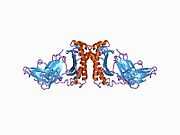HFE (gene)
Human hemochromatosis protein also known as the HFE protein is a protein which in humans is encoded by the HFE gene.
The HFE gene is located on short arm of chromosome 6 at location 6p22.2. Unusually, the official gene symbol (HFE for High Iron Fe) is not an abbreviation of the official name (hemochromatosis).[1]
Function
The protein encoded by this gene is a membrane protein that is similar to MHC class I-type proteins and associates with beta-2 microglobulin (beta2M). It is thought that this protein functions to regulate iron absorption by regulating the interaction of the transferrin receptor with transferrin.[2]
Clinical significance
The iron storage disorder hereditary hemochromatosis (HHC) is an autosomal recessive genetic disorder that usually results from defects in this gene.
The mutation or polymorphism most commonly associated with hemochromatosis is p. C282Y. About 1/200 of people of Northern European origin have two copies of this variant; they, particularly males, are at high risk of developing hemochromatosis.[3]
Interactions
The HFE protein has been shown to interact with TFRC.[4][5]
Its primary mode of action is then through regulation of the iron storage hormone hepcidin.[6]
References
- ↑ "HGNC: HFE".
- ↑ "Entrez Gene: HFE hemochromatosis".
- ↑ "Hemochromatosis".
- ↑ Feder JN, Penny DM, Irrinki A, Lee VK, Lebrón JA, Watson N et al. (Feb 1998). "The hemochromatosis gene product complexes with the transferrin receptor and lowers its affinity for ligand binding". Proceedings of the National Academy of Sciences of the United States of America 95 (4): 1472–7. doi:10.1073/pnas.95.4.1472. PMC 19050. PMID 9465039.
- ↑ West AP, Bennett MJ, Sellers VM, Andrews NC, Enns CA, Bjorkman PJ (Dec 2000). "Comparison of the interactions of transferrin receptor and transferrin receptor 2 with transferrin and the hereditary hemochromatosis protein HFE". The Journal of Biological Chemistry 275 (49): 38135–8. doi:10.1074/jbc.C000664200. PMID 11027676.
- ↑ Nemeth E, Ganz T (2006). "Regulation of iron metabolism by hepcidin". Annual Review of Nutrition 26: 323–342. doi:10.1146/annurev.nutr.26.061505.111303. PMID 16848710.
Further reading
- Dorak MT, Burnett AK, Worwood M (Mar 2002). "Hemochromatosis gene in leukemia and lymphoma". Leukemia & Lymphoma 43 (3): 467–77. doi:10.1080/10428190290011930. PMID 12002748.
- Beutler E (May 2003). "The HFE Cys282Tyr mutation as a necessary but not sufficient cause of clinical hereditary hemochromatosis". Blood 101 (9): 3347–50. doi:10.1182/blood-2002-06-1747. PMID 12707220.
- Ombiga J, Adams LA, Tang K, Trinder D, Olynyk JK (Nov 2005). "Screening for HFE and iron overload". Seminars in Liver Disease 25 (4): 402–10. doi:10.1055/s-2005-923312. PMID 16315134.
- Distante S (2006). "Genetic predisposition to iron overload: prevalence and phenotypic expression of hemochromatosis-associated HFE-C282Y gene mutation". Scandinavian Journal of Clinical and Laboratory Investigation 66 (2): 83–100. doi:10.1080/00365510500495616. PMID 16537242.
- Zamboni P, Gemmati D (Jul 2007). "Clinical implications of gene polymorphisms in venous leg ulcer: a model in tissue injury and reparative process". Thrombosis and Haemostasis 98 (1): 131–7. doi:10.1160/th06-11-0625. PMID 17598005.
External links
PDB gallery |
|---|
| | 1a6z: HFE (HUMAN) HEMOCHROMATOSIS PROTEIN |
| 1de4: HEMOCHROMATOSIS PROTEIN HFE COMPLEXED WITH TRANSFERRIN RECEPTOR |
|
|
|
|
|---|
| | Transition metal | |
|---|
| | Electrolyte | Sodium metabolism | |
|---|
| Phosphate metabolism | |
|---|
| | |
|---|
| | |
|---|
|
|---|
| |
|---|
| | Description |
- Vitamins
- Cofactors
- Metal metabolism
- Fats
- metabolism
- intermediates
- lipoproteins
- Sugars
- Glycolysis
- Glycogenesis and glycogenolysis
- Fructose and galactose
|
|---|
| | Disease |
- Vitamins
- Carbohydrate
- Lipid
- Metals
- Other
- Symptoms and signs
|
|---|
| | Treatment |
- Drugs
- Vitamins
- Mineral supplements
|
|---|
|
|
|
|---|
| | Arrestin | |
|---|
| | Membrane-spanning 4A |
- MS4A1
- MS4A2
- MS4A3
- MS4A4A
- MS4A4E
- MS4A5
- MS4A6A
- MS4A6E
- MS4A7
- MS4A8B
- MS4A9
- MS4A10
- MS4A12
- MS4A13
- MS4A14
- MS4A15
- MS4A18
|
|---|
| | Myelin | |
|---|
| | Pulmonary surfactant | |
|---|
| | Tetraspanin | |
|---|
| | Other/ungrouped | |
|---|
| see also other cell membrane protein disorders
Index of cells |
|---|
| | Description |
- Structure
- Organelles
- peroxisome
- cytoskeleton
- centrosome
- epithelia
- cilia
- mitochondria
- Membranes
- Membrane transport
- ion channels
- vesicular transport
- solute carrier
- ABC transporters
- ATPase
- oxidoreduction-driven
|
|---|
| | Disease |
- Structural
- peroxisome
- cytoskeleton
- cilia
- mitochondria
- nucleus
- scleroprotein
- Membrane
- channelopathy
- solute carrier
- ATPase
- ABC transporters
- other
- extracellular ligands
- cell surface receptors
- intracellular signalling
- Vesicular transport
- Pore-forming toxins
|
|---|
|
|





